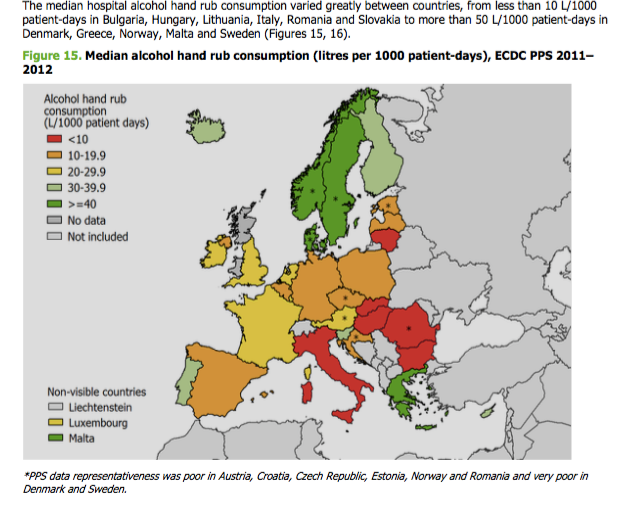Schema della sezione
-
Instructions
Read the Case scenario on Hospital hand hygiene which introduces this lesson. After, watch the video as many times as you wish and answer the online questions. Participate in the forum with your colleagues and read the documents which are shown below and in the links in resources. These documents provide research evidence for you to complete the final written exercise: an online petition.
You can write in English and in Italian. We work in a bilingual system, but you need to read the evidence in English!
Case Scenario
You are a medical student at Umberto I. You have noticed that soap in public areas of the hospital and in toilets for students and visitors is often absent. Some students carry their own gels, but not all. Visitors to the hospital have similar problems. They can't wash their hands properly before and after visiting their loved ones You have not, for example, seen many alcohol-based gel dispensers in the patient areas for use by students or relatives and friends visiting patients. Is this a safety risk for patients? You seem to remember seeing that hand hygiene dispensers were available to the public at some other hospitals in your city – e.g. Frati Beni Fratelli – and are concerned that a large teaching nosocomio like Umberto I is not providing these to hundreds of visitors and students studying and working in the hospital every day. You ask yourself if this has a negative effect on patients in the hospital.
Look at the video from the Centre for Disease Control (CDC, USA) and answer the questions. After, share your own experiences and impressions on the Forum 'Mani pulite al Policlinico'
-
Watch a medic at the prestigious international centre for disease control explain the need for hand hygiene in our hospitals.
-
Instructions
Watch the video as many times as you like then answer the questions.
-
Instructions
This is an open bilingual forum for students to share your experiences. You can post in English or Italian. You don't have to participate if you don't want to. The questions are to get started:
How easy is it to wash your hands at Umberto I?
How easy is it for the public? What about doctors, nurses and health care providers?
Should the faculty of medicine be concerned?
The data in the table below compares hand cleansing alcohol rubs in Europe. Does the data in Italy surprise you? (You can find the complete report in Resources below)

-
Instructions
Read the document on 'Hand Hygiene compliance' to learn how one group of researchers studied hand hygiene among visitors to their hospital. When you finish, click on the 'Reading' link here and answer the questions in the quiz below the text.
Letters to the editor
Hand hygiene compliance by visitors to
Hospitals: can we do better?
To the Editor:
We read with interest the recent article by Birnbach et al,1 which observed hand hygiene compliance (HHC) by visitors to a private university hospital and the effect of visual cues on HHC. The authors report a rate of HHC at the main hospital entrance by visitors of just 0.52% at baseline, which increased to a HHC rate of 11.67% with the aid of visual cues and a large freestanding alcohol- based hand sanitizers (AHS) dispenser. We report similar and additional interventions undertaken to encourage and improve HHC by visitors attending our hospital.
Connolly Hospital Blanchardstown (CHB) is a 300-bed general hospital in Dublin, Ireland. In Ireland, as in other countries, reduction in health care-associated infections and improvement in HHC by health care workers is recognized as a key priority to improve delivery of safe patient care. Indeed, since 2011, Irish health authorities have requested acute hospitals to report 6 monthly rates of HHC by health care workers by using a hand hygiene observational audit tool based on the World Health Organization 5 moments of hand hygiene. The Irish health authorities have set targets of HHC by health care workers of 75% in 2011 and >90% by 2013. However, the compliance of hospital visitors with hand hygiene is largely unmonitored, unreported, and varies widely in the published literature (0.52%-57%).1-3 HHC compliance by visitors is important to prevent transmission of potentially harmful pathogens, acquired in the community, to already vulnerable hospitalized patients. To measure HHC by visitors attending our hospital, we performed a directly observed study of visitor HHC, over a total of 9 hours, on 5 nonconsecutive days during September 2011. Observation of HHC compliance by visitors was performed between 14:00 and 20:00 hours during the study period. All visitors were monitored for use of AHS while passing an AHS dispensing unit located at 3 distinct locations within the hospital: the main foyer, entrance to 4 different acute wards, and within the wards at the point of access to the single rooms. The level of promotion of hand hygiene however varied in a stepwise manner from a large freestanding hand hygiene promotion unit with AHS dispensers in the main hospital foyer bearing the slogan “clean hands save lives” and “talking posters,” which reminded staff/visitors to wash their hands, to laminated reminder messages on the floor directing the visitor to a single AHS dispensing unit placed on the wall at ward entrances and finally a single AHS dispensing unit but no hand hygiene prompts at the entrance to single patient rooms. As well as the large hand hygiene promotion unit at the main entrance, the glass entrance doors to the hospital and main foyer also contained large stickers advising visitors to practice hand hygiene.
A total of 823 hand hygiene opportunities by hospital visitors was observed during the study period. Visitor HHC was shown to vary by location, with 44% (262/592) of visitors performing hand hygiene at the hospital entrance, 4.1% (8/194) at the ward entrance, and 2.7% (1/37) at entrance to single rooms. A mean compliance of 34.2% for a total of 823 hand hygiene opportunities was recorded with an increased level of HHC at main hospital entrance versus other locations. This is in keeping with the improved level of compliance when using visual and physical cues as described by Birnbach et al,1 but the significantly increased level of compliance in our study (44% vs 11.67%, respectively) may be due to increased visual, audio, and physical cues and provides even more definitive evidence of the benefit of such hand hygiene promotion. Given the lower levels of compliance in other areas of our hospital, it is hoped that such cues will in the future be placed throughout the hospital to improve levels of HHC by compliance by visitors at these locations. Hand hygiene promotion cues for visitors should be adopted by all hospitals to reduce the risk of transmission of potentially infectious organisms to already vulnerable patients by visitors.
References
1. Birnbach DJ, Nevo I, Barnes S, Fitzpatrick M, Rosen L, Everett-Thomas R, et al. Do hospital visitors wash their hands? Assessing the use of alcohol- based hand sanitizer in a hospital lobby. Am J Infect Control 2012;40: 340-3. RandleJ,ArthurA,VaughanN.Twenty-four-hourobservationalstudyofhospital hand hygiene compliance. J Hosp Infect 2010;76:252-5.
Savage J, Fuller C, Besser S, Stone S. Use of alcohol hand rub (AHR) at ward entrances and use of soap and AHR by patients and visitors: a study in 27 wards in nine acute NHS trusts. J Infect Prevent 2011;12:54-8.
DOI of original article:10.1016/j.ajic.2011.05.006. Conflicts of interest: None to report.
Rebecca Wolfe, BEng
School of Medicine Royal College of Surgeons in Ireland Dublin, Ireland
Eoghan O’Neill, MB, BCh, BAO, PhD* Department of Clinical Microbiology Royal College of Surgeons in Ireland and Department of Microbiology Connolly Hospital Dublin, Ireland
* Address correspondence to Eoghan O’Neill, Department of Microbiology, Connolly Hospital, Dublin 15, Ireland. E-mail address: eoneill@rcsi.ie (E. O’Neill)
Available at : doi:http://dx.doi.org/10.1016/j.ajic.2012.07.007
-
This is the WHO report (2011) on the international programme to promote hand hygiene. The report is a systematic review. It analyses the international evidence on hospital infections and hand hygiene. Read the summary and look briefly at the tables and maps. Italy's hospital infection rates are within the average advanced country rates, but its antibiotic resistance is among the highest. Could hand hygiene programs contribute to reducing this resistance? The question is open.
-
RESOURCE : This is the most recent report comparing EU countries 2012.
Point prevalence survey of healthcare-associated infections and antimicrobial use in European acute care
2011-12hospitals
-
Imagine you want to create a public online petition to hospital authorities to have hand hygiene dispensers installed in public areas. Write a short statement of the problem (max 200 words) in English or Italian and cite explicitly the evidence in the documents in this module (e.g. World Health Organization (WHO) Report
Follow this sequence to structure your description in 5-6 sentences.
1. State clearly the potential problem of hand hygiene in your hospital and why it is important for you.
2. Refer to international evidence concerning hand hygiene in hospitals and health impacts
3. Make a pro active suggestion about what hospital authorities should do to reduce risks
4. Invite medical and nursing students, health care staff and members of the public to sign your petition.
-
If you think social media can impact where you work and study to improve conditions then this link to a free online petition software may interest you! It is multilingual and can be linked to other social media you use. Would a petition to the 'Direttore Sanitario' have any impact? And what about the faculty of medicine? Have fun!
-
Do you really know how to wash your hands correctly in a hospital? If you are not sure, watch the video! This is how the World Health Organization says how you should do it.
-
This is a short summary of the International evidence. Read the paper, by Kampf (2009) Hand Hygiene for the Prevention of Nosocomial Infections, then answer the questions in the quiz.

-
The questions here are about the paper entitled Hand Hygiene for the Prevention of Nosocomial Infections. There are 15 questions and you have 15 minutes. Read the paper as many times as you like, then try to answer the questions quickly.
-

